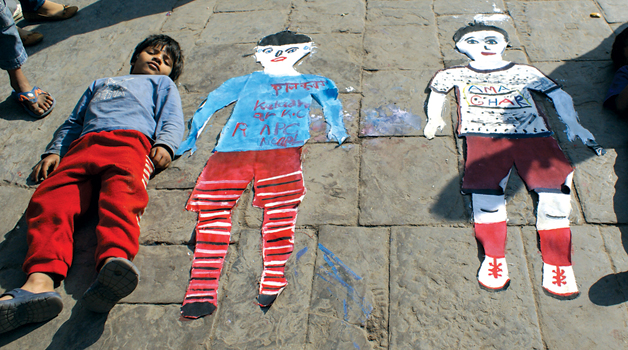
He shows me a clipping from Kathmandu Post dated December 11, 2008. It has a photo of a small boy painting on a piece of paper in Kathmandu Durbar Square, as part of an art activity for street children. He says, “This small chap, Sujan, responded well to our efforts. He was finding himself to be a good artist. He is in Pokhara now.” While he says this, Juju Kazi Maharjan’s face glows a little, although it’s hard to discern, seeing that he is so swarthily dark skinned. But, still, the enthusiasm in his voice cannot be missed. Sujan is just one of the hundreds of street children he has helped to explore self-creativity and, thus, find themselves more worthy in society. Juju Kazi’s father, Hira Kazi Maharjan, has been a life long social activist involved in community development work and it seems that he has passed on this particular gene to his son. “Yes, I think that may be true,” says Juju Kazi. “Although professionally I am an artist, I am irresistibly drawn towards social work.”
Five years ago, he discovered a way to fulfill both his callings. He founded an organization called Heartbeat whose mission would be to conduct social activities through art. In the five years since, Heartbeat has been active in what it calls the field of Art for Development, or ‘Art4D’. Under Art4D, Heartbeat has initiated and organized many art workshops and exhibitions with disadvantaged children to support social causes. It is a diverse group of concerned individuals that includes, among others, local artists and social workers. Heartbeat has initiated almost 50 creative art events to date. Some examples are the Hunger-Free Campaign, Children’s Art Workshop with Action Aid International, and the Celebration of Children’s Right on Human Rights Day with Art4D France.
Heartbeat has already held more than ten national and international exhibitions as well as about 20 workshops. Heartbeat works in association with more than 15 childrens organizations including INGOs and youth groups through the medium of visual arts for social causes like migration, development, food and human rights, drugs and poverty reduction. ‘Art for Social Change’ is its motto and it proposes to bring in positive changes through the medium of art. Heartbeat promotes art activities to develop art as a viable vocational subject. It also uses art as a means to raise awareness about social causes; improve global communication on art; development of education, improvement of street children’s lives; augmentation of tourism efforts; and encouragement of creativeness in children and in society as a whole. Heartbeat also campaigns for issues like human rights, a hunger-free society and the right to food, as well as migration and drug abuse.
In addition, Heartbeat supports activities to ensure education for children. The organization is also involved in social event management mainly as a coordinator and through networking. Most of Heartbeat’s work is directed towards marginalized communities and it also takes part in lobbying for the humanist movement in Nepal. On the occasion of International Earth Day 2009 earlier this year, Heartbeat in association with Leo Club and YES Nepal organized an art workshop at Basantpur, Kathmandu, which brought together disadvantaged children for an awareness campaign on different environmental issues. The program coordinator, Juju Kaji Maharjan, hoped to give children a chance to voice their concerns and raise awareness among the public about environmental issues through their creative expression and the play of colors on paper.
Maharjan is a sculptor, visual artist and youth social activist as well as a freelance writer. He is also a Youth Ambassador for Peace (2008), besides being a founder member of Heartbeat. He completed his fine art studies from Nepal’s Lalitkala Fine Art Campus this year. He is also the founder member of Eliviras Children’s Home (and orphanage) which was established in 2006, and is a member of Gokem Art and Artists Society of Nepal. Today, although Heartbeat is associated with hundreds of other social service and youth organizations, it still conducts its many activities through personal funding. Says Juju Kazi, “We conducted some art exhibitions to raise funds, but since most people are not interested in purchasing art by children, we have discontinued this practice.” To my question as to why Heartbeat has not solicited support from established artists here, he says, “Well, I am thinking of doing that in the future.” Let us hope that the art world comes together to help Juju Kazi and Heartbeat to conduct a drive to raise the much needed funds to enable it to continue its good work.
Juju Kazi also says that “Currently, our focus is also on advocacy for climate change as well as art for rural development. We have a program in Jan Kalyan Primary School in Nagarkot that has been going for four years now. And we are planning to advocate for climate change in the Himalayan region (Mustang, etc.).” All the best Juju Kazi - may your heart beat strong.










